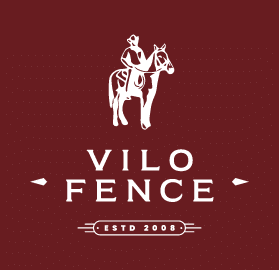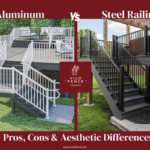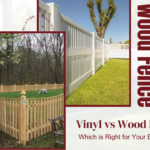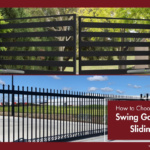Many people wonder, Which railing material is best for my property? When choosing the right railing, aluminum and steel are two materials that often come up for consideration. Both materials offer durability, security, and aesthetic appeal, but they also come with distinct characteristics that make them more or less suitable for specific applications. Consulting with railing contractors can help you make an informed decision, as they can guide you through the pros and cons of each material and assist with installation.
In this blog, we will explore the differences between aluminum and steel railings to help you choose the best option for your needs.
What Are Aluminum Railings?

Aluminum railings are lightweight, resistant to corrosion, and often chosen for their sleek, modern appearance. These railings are typically used in residential and commercial applications, including balconies, decks, and staircases. Because of aluminum’s resistance to rust, these railings are very suitable for outdoor application, especially in areas with high humidity and regions with a lot of saltwater which could promote corrosion on other metals.
Pros of Aluminum Railings:
- Lightweight: Aluminum railings are lighter in weight compared to steel; hence, they are easier to install. Working with larger areas or multi-level buildings can be a big advantage.
- Rust-Resistant: Aluminum does not rust, making it ideal for areas with extreme weather conditions or railings exposed to moisture, such as near pools or balconies.
- Low Maintenance: Aluminum railings require minimal maintenance. They do not need to be painted regularly like steel railings, though they can be painted for added aesthetics or protection.
- Aesthetic Flexibility: Aluminum railings can be molded into various shapes and sizes, allowing for a modern, clean aesthetic. You can find aluminum railings in various colors and finishes, including powder coating for added durability and appearance.
Cons of Aluminum Railings:
- Not as Strong as Steel: Durable, aluminum is not as strong. If your requirement is heavy duty railings for high traffic or high-risk areas then steel may be a better option.
- Susceptibility to Dents: Aluminum railings tend to dent and scratch more than steel. Even though they are rust resistant, their tendency to be lighter in nature means they are more susceptible to physical damage.
- Cost: High-quality aluminum railings can be expensive, especially when custom-made or with specific finishes like powder coating.
What Are Steel Railings?
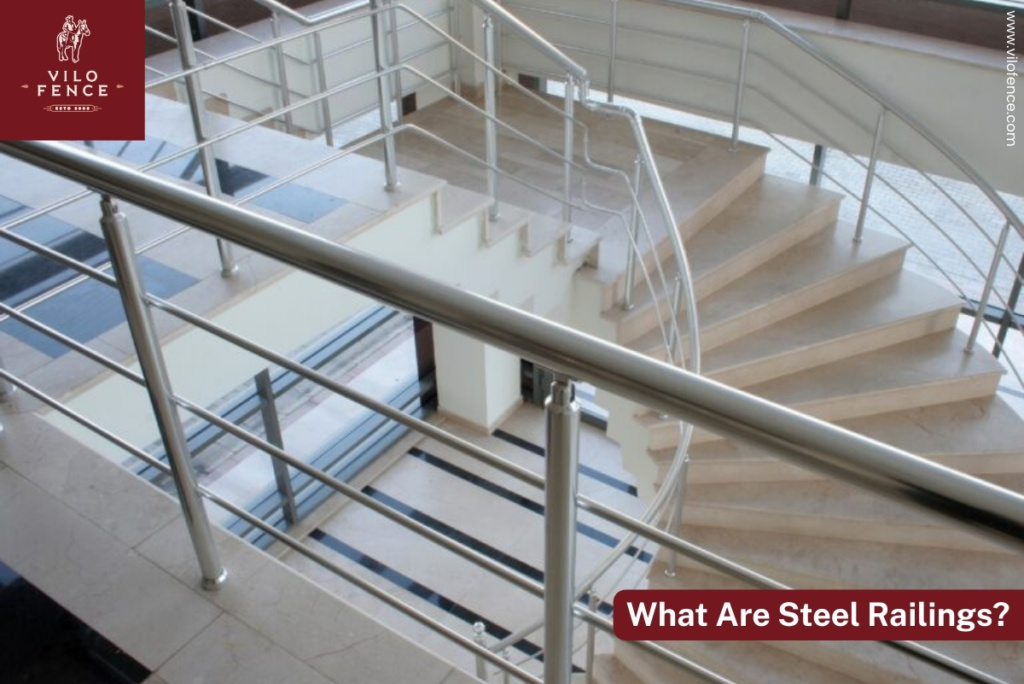
On the other hand, steel railings are known for their robustness and strength. Steel is a product of choice for people who are concerned with security and longevity. It is particularly used in commercial or industrial settings or in places where safety is a high priority. Steel railings are also installed in outdoor areas, though they may need more maintenance than aluminum.
Pros of Steel Railings:
- Strength and Durability: Steel is incredibly strong and capable of withstanding heavy impacts. It is perfect for environments where security and durability are critical, like stairways or high-traffic areas.
- Long-Term Investment: Steel is the material of choice for those who want something safe and long-lasting. They are less likely to need replacement and can endure harsh weather conditions when properly maintained.
- Variety of Styles: Steel railings can be customized with various designs, including intricate wrought iron patterns. No matter if you are drawn to the sleek, modern look or the ornate style of running, you can apply steel railings to your preferences.
- Security: Steel railings are used for high-security needs because they provide more protection. Steel is harder to damage or break into, making it a great choice for safety-conscious property owners.
Cons of Steel Railings:
- Prone to Rust: Unlike aluminum, steel is susceptible to rust, particularly in coastal or humid areas. If you live near water or experience heavy rain, steel railings may require more maintenance to prevent corrosion.
- Heavier Weight: Since steel is much heavier than aluminum, installation is often more complicated. Also, because steel is so heavy, extra support is often needed during installation, adding more to the overall labor expenses.
- Maintenance Requirements: Steel railings may need to be repainted or treated regularly to prevent rust. This increases the long term maintenance costs as compared to aluminum railings.
- Cost: Even though steel is pricier than aluminum because of its strength, many people think the extra durability and security are worth it.
With the expertise of railing service professionals, you can ensure proper installation and long-term care of your steel railings, minimizing the maintenance required over time.
Aesthetic Differences: Aluminum vs. Steel Railings
When it comes to aesthetics, railings made of steel or aluminium each have unique styles that can improve the appearance of your property.
- Aluminum: Aluminum railings are often sleek and modern. They can be painted in various colors and finished with powder coatings for a smooth, stylish appearance. These railings are typically more minimalist and can offer a clean, unobtrusive look. Aluminum railings are perfect for contemporary properties or modern deck designs where an open, airy feel is desired.
- Steel: Steel railings provide a more classic, heavy industrial look. They can be designed with intricate, decorative elements, making them ideal for homes with classic or Victorian styles. Steel can also be more customizable with options like wrought iron patterns, making it suitable for decorative and functional purposes.
Your choice of materials is mostly determined by how your property looks. For a modern design, aluminum would probably work best. However, for a more ornate or classic feel, steel may suit your needs better. Whether you choose aluminum or steel, railing installers near me can help you with professional installation to ensure the best results for your property.
Which Material is Best for You?
Choosing between aluminum and steel railings ultimately depends on your specific needs and preferences. If you’re looking for something lightweight, low-maintenance, and rust-resistant, aluminum railings may be the better choice. They are perfect for residential and commercial applications where longevity and modern aesthetics are key priorities.
On the other hand, if you’re looking for strength, durability, and security in a high-traffic area, steel railings offer the robustness and structural integrity needed for such environments. While steel requires more maintenance, it provides an unmatched sense of safety and security. For expert installation, consider consulting with reliable stair railing installers near me for a professional and seamless setup.
How Can Railing Service Help You?
Whether you’re interested in aluminum or steel railings, professional railing companies providers can offer expert advice, installation, and maintenance. Railing providers and installers can ensure your railing is installed correctly, safely, and meets your aesthetic goals. By consulting with trusted companies, you can benefit from custom designs, accurate installations, and the assurance of high-quality materials.
Local professionals can provide personalized services tailored to your unique needs if you’re searching for stair railing installers. They can assess your property, recommend the best railing options, handle installation, and provide long-term care.
Conclusion
Choosing between aluminum vs. steel railings depends on factors such as budget, aesthetic preferences, and the level of durability you need. Aluminum railings offer a lightweight, low-maintenance option with modern appeal, while steel railings provide strength and security for high-traffic or high-risk areas. Regardless of the material, it’s essential to consult with railing service professionals like Vilo Fence, who can help you make the best choice and ensure that your railings are expertly installed and maintained.
By working with trusted railing contractors, you’ll enjoy a beautiful and functional railing solution that enhances your property for years to come.
FAQ’s
Q1. What are the main differences between aluminum and steel railings?
Ans. Aluminum railings are lightweight, low-maintenance, and rust-resistant, ideal for modern homes. Steel railings are stronger, more durable, and better suited for high-traffic areas.
Q2. What material is more affordable, aluminum or steel?
Ans. Aluminum is generally more affordable than steel, but steel offers greater strength and security, which can justify the higher cost for certain applications.
Q3. Do aluminum railings require a lot of maintenance?
Ans. No, aluminum railings are low-maintenance. They don’t rust and only need occasional cleaning. They may be painted for aesthetics, but don’t require frequent upkeep like steel.
Q4. Are steel railings prone to rust?
Ans. Steel railings are susceptible to rust, especially in humid or coastal areas, and require regular maintenance to prevent corrosion.
Q5. How can railing service professionals help me?
Ans. Railing service professionals can assist with design, installation, and maintenance, ensuring that your railings are properly installed and meet your aesthetic and safety needs.
